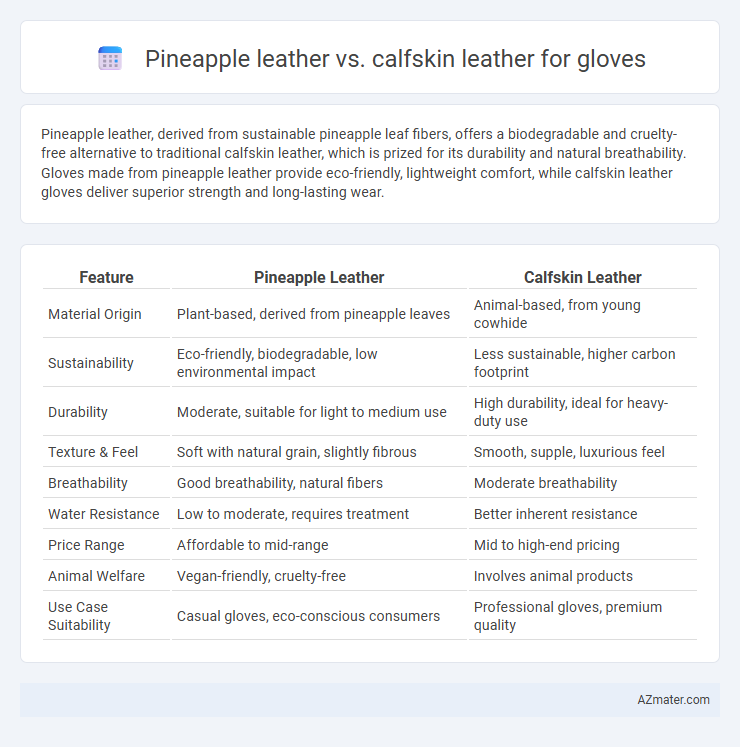Pineapple leather, derived from sustainable pineapple leaf fibers, offers a biodegradable and cruelty-free alternative to traditional calfskin leather, which is prized for its durability and natural breathability. Gloves made from pineapple leather provide eco-friendly, lightweight comfort, while calfskin leather gloves deliver superior strength and long-lasting wear.
Table of Comparison
| Feature | Pineapple Leather | Calfskin Leather |
|---|---|---|
| Material Origin | Plant-based, derived from pineapple leaves | Animal-based, from young cowhide |
| Sustainability | Eco-friendly, biodegradable, low environmental impact | Less sustainable, higher carbon footprint |
| Durability | Moderate, suitable for light to medium use | High durability, ideal for heavy-duty use |
| Texture & Feel | Soft with natural grain, slightly fibrous | Smooth, supple, luxurious feel |
| Breathability | Good breathability, natural fibers | Moderate breathability |
| Water Resistance | Low to moderate, requires treatment | Better inherent resistance |
| Price Range | Affordable to mid-range | Mid to high-end pricing |
| Animal Welfare | Vegan-friendly, cruelty-free | Involves animal products |
| Use Case Suitability | Casual gloves, eco-conscious consumers | Professional gloves, premium quality |
Introduction to Pineapple Leather and Calfskin Leather
Pineapple leather, also known as Pinatex, is an innovative, sustainable material made from pineapple leaf fibers, offering a cruelty-free and biodegradable alternative to traditional leather. Calfskin leather, derived from young cowhide, is prized for its softness, durability, and luxurious texture, commonly used in high-quality gloves. While pineapple leather appeals to eco-conscious consumers seeking vegan options, calfskin remains favored for its natural flexibility and premium feel.
Material Origins: How Each Leather Is Made
Pineapple leather, also known as Pinatex, is crafted from the cellulose fibers found in pineapple leaves, representing a sustainable and vegan alternative to traditional leather. Calfskin leather comes from the hide of young calves, undergoing a tanning process that enhances durability and suppleness for luxury gloves. The eco-friendly production of pineapple leather contrasts with the animal-based origins and resource-intensive manufacturing of calfskin.
Environmental Impact and Sustainability
Pineapple leather, made from pineapple leaf fibers, offers a sustainable and eco-friendly alternative to traditional calfskin leather by utilizing agricultural waste and reducing reliance on animal farming. Its production consumes less water and generates fewer greenhouse gas emissions compared to the resource-intensive processes involved in calfskin leather tanning. Choosing pineapple leather gloves supports a lower environmental footprint and promotes circular economy principles in the fashion industry.
Durability and Longevity Comparison
Pineapple leather, made from pineapple leaf fibers, offers a sustainable and lightweight alternative to traditional calfskin leather, yet it generally exhibits lower durability and less resistance to wear. Calfskin leather is renowned for its high tensile strength, natural flexibility, and longevity, making it ideal for gloves requiring long-term use and frequent handling. While pineapple leather is biodegradable and eco-friendly, calfskin gloves maintain superior performance through extended use due to their robust fiber structure and natural oils.
Comfort and Breathability in Gloves
Pineapple leather offers superior breathability compared to calfskin leather, making gloves more comfortable in warm conditions by allowing better air circulation and moisture management. Calfskin leather, known for its softness and durability, provides excellent comfort but may retain heat and moisture, potentially causing discomfort during extended wear. For gloves, pineapple leather's natural ventilation properties enhance overall comfort, especially in humid environments.
Aesthetic Qualities and Design Versatility
Pineapple leather offers a distinctive textured surface with a natural, organic look that enhances the aesthetic appeal of gloves through its unique pattern and subtle color variations. Calfskin leather provides a smooth, refined finish with a consistent grain, enabling sleek and classic glove designs that emphasize elegance and sophistication. Design versatility is greater with calfskin due to its pliability and ability to take detailed embossing or dyeing, while pineapple leather excels in eco-conscious styles seeking an unconventional and sustainable leather alternative.
Maintenance and Care Requirements
Pineapple leather requires minimal maintenance since it is naturally resistant to water and stains, making it an excellent choice for gloves exposed to moisture or dirt. Calfskin leather demands regular conditioning and careful cleaning to prevent drying and cracking, ensuring its softness and durability over time. Both materials benefit from avoiding prolonged exposure to direct sunlight and heat to preserve their texture and longevity.
Cost and Market Availability
Pineapple leather for gloves offers a cost-effective and sustainable alternative, typically priced lower due to its use of agricultural waste and emerging production methods. Calfskin leather remains widely available with a well-established market, commanding higher prices linked to its durability and premium tactile qualities. Limited production and evolving supply chains of pineapple leather impact its market availability compared to the abundant calfskin options.
Ethical Considerations in Leather Choice
Pineapple leather, derived from sustainable plant fibers, significantly reduces animal cruelty and environmental impact compared to traditional calfskin leather, which involves livestock farming and associated ethical concerns. The use of pineapple leather supports cruelty-free practices and a lower carbon footprint, aligning with vegan and eco-conscious consumer values. Choosing pineapple leather gloves promotes responsible sourcing and contributes to reducing demand for animal-based leather products.
Final Verdict: Which Leather Is Better for Gloves?
Pineapple leather offers sustainable, eco-friendly benefits with a lightweight, flexible texture suitable for gloves, while calfskin leather provides superior durability, natural breathability, and a classic luxurious feel. Calfskin excels in long-term wear resistance and comfort, making it ideal for high-quality, performance gloves. For those prioritizing sustainability and vegan materials, pineapple leather is a strong contender, but calfskin remains the top choice for premium glove craftsmanship.

Infographic: Pineapple leather vs Calfskin leather for Glove
 azmater.com
azmater.com